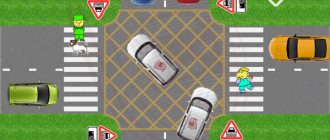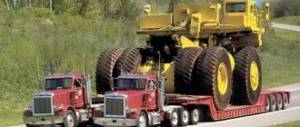Who is lobbying for increased speed on Russian roads?
Until 2009, there was only one government agency in Russia that was entrusted with the functions of managing federal roads - Rosavtodor, which is part of the Ministry of Transport of the Russian Federation. The total length of Russian highways of federal importance is no less than almost 51 thousand km.
And in the summer of 2009, special Federal Law No. 145 created another state structure in the field of road management, subordinate directly to the government of the Russian Federation -. Only 2.7 thousand highways are transferred to its management, among which the most “tasty” from the point of view of further commercialization are the M1, M3, M4, M11 highways.
Already now there are toll sections on the M1 and M4 highways, for which the truck driver pays Avtodor up to 400 rubles. Naturally, the higher the speed of movement, the greater the income of the state-owned company. That is why its management, back in December 2012, approached the traffic police with a proposal to max. The permitted speed on the highway was raised from the current value of 110 km/h to 130 km/h.
The traffic police responded by demanding guarantees that the roads controlled by Avtodor meet the “Highway” class according to GOST. This means the presence of four or more lanes 3.75 m wide with a central dividing strip and a multi-level intersection of other roads.
Factors affecting driving speed
Cyclist training level
The speed of movement depends most on the physical strength and endurance of the rider. The rider's experience has a greater influence on riding speed than the type of bike he chooses. When riding on the road, an experienced mountain biker will be able to keep novice road bike riders on their tail, maintaining a higher speed even when going uphill.
Oncoming air resistance
At speeds of 25-27 km/h, air resistance significantly slows down the movement of the bicycle. If a headwind blows, it becomes difficult to move even at a speed of 10-15 km/h. On a mountain bike with wide and high handlebars, and especially with a low saddle, it is much harder to pedal at a speed of 30 km/h than on a road bike. The road bike has a special detail - a narrow handlebar with a lower grip (ram's horns). When there is noticeable headwind resistance, a road bike rider can bend down to the handlebars, grabbing the handlebars at the bottom of the arc, thus significantly reducing the load.
You can completely get rid of oncoming air pressure only by driving into an air bag, under the protection of a bus or truck in front. But getting behind a bus or truck is very dangerous, as they can suddenly brake or turn when going around a hole.
Rolling resistance
This opposition is especially felt at the beginning of the movement. It takes more energy from both the cyclist and the car engine to accelerate from a standstill. Once you start moving, rolling resistance has less of an impact on the amount of force required for acceleration. As the speed increases, this resistance gradually decreases.
Increasing the friction between the tire and the road primarily increases the amount of rolling resistance. A narrow tire that has pressed through soft ground is difficult to tear off the ground. A tire with a wide-spaced tread rubs excessively on hard asphalt surfaces and also wears out quickly. Therefore, you should choose tires based on width, tread area and depth, taking into account the roads on which you will ride your bike.
The pressure in the tube significantly affects the friction between the tire and the road. The more the chamber is inflated, the easier the wheel rolls on asphalt and hard ground. To make driving on crushed stone, sand, mud, and snow easier, it is recommended to reduce the pressure in the chambers.
The heavy weight of the bike greatly increases the rolling resistance. Accelerating and pushing a heavy mountain bike uphill is always more difficult than a lighter road bike.
Increasing the wheel diameter reduces the amount of rolling resistance. A bicycle for adults coasts in a straight line much longer than a bicycle for children. In addition, a large wheel overcomes road unevenness more easily, rolling over small holes.
Friction in transmission mechanisms
An unlubricated or dirty chain, as well as worn bushings and carriage will likely reduce the speed of the bike. If you want to achieve high speed, then you need to buy expensive bushings and a carriage mechanism, and then monitor the condition of their lubrication.
Shock absorbers on a bicycle, especially ones that are too soft, reduce speed on smooth asphalt. But they turn out to be indispensable when overcoming road sections with minor irregularities. The shock-absorbing fork turns out to be irreplaceable when driving around the city, while the rear suspension can be abandoned.
In general, you shouldn’t strictly adhere to the above average speeds, especially the maximum ones. You should ride your bike at a speed that is comfortable for you and enjoy the ride.
Why the permitted highway speed of 130 km/h does not suit the Ministry of Transport
Then, at the beginning of 2013, representatives of the relevant ministry intervened in the matter and opposed this decision. The fact is that in addition to the concept of “permitted maximum speed on the highway,” which is mainly used by road maintenance workers and the traffic police, there is also the concept of “maximum design speed on highways.” It is used mainly by road designers and builders.
Under existing traffic rules and the Code of Administrative Offenses of the Russian Federation, drivers can, without fear of punishment, increase the speed above the maximum permitted by 20 km/h. It turns out that if the permitted speed on the highway is 110 km/h, then the actual speed at which vehicles can travel along it reaches 130 km/h, and if the permissible speed is up to 130 km/h, then its real value reaches 150 km /h. This is what designers and builders should be guided by.
Naturally, as this indicator increases, the costs of road construction increase. So the interests of various departments collided on this issue. Avtodor, which is directly controlled by the government, lobbied for an increase in speed, but the Ministry of Transport, which apparently supervises it, opposed this.
The average running speed of an ordinary person.
When determining the average running speed of an ordinary unprepared person, it is necessary to take into account the following circumstances:
- Child's running speed.
- Running speed of an adult man.
- Woman's running speed.
If we are talking about a child running, then in this case there is no need to take into account who is running - a boy or a girl, since their speed is almost the same and is approximately 8 - 10 km/h. This is due to the fact that children, regardless of their gender, have the same development of the muscular system of the musculoskeletal system. They also have the same amount of lactic acid and pulse rate after exercise.
If we are talking about an adult running, then the average speed will be slightly different. This is due to the fact that females have a subcutaneous fat ratio that is 10% higher than that of males, which makes it significantly more difficult for the weaker half of humanity to increase their speed. In addition, there is a difference in the development of elastic and soft muscles. Thus, a woman’s running speed is 11–14 km/h, a man’s is 15–20 km/h. You can more accurately determine the speed at which a person runs at a distance of 100 m. Of course, not everyone is able to run it. Elderly people or those who are overweight or have some kind of disease will run it more slowly than an ordinary healthy person, whose speed will be 14-16 seconds for women and 12-15 seconds. in men. But this indicator is not unambiguous. If an ordinary untrained person runs every day, his result may improve first by hundredths of a second, and then by tenths. Of course, at the beginning the leg muscles will hurt, but if you train constantly, the pain will go away, and the speed of the race will increase every month. But at the same time, you need to monitor not only your speed, but also how you feel during the run and after it. Even if you feel slightly unwell, you should consult a doctor who will recommend you one or another jogging system.
The Prime Minister gets involved
The departments' litigation dragged on until the summer of 2013, until at the end of July Prime Minister Medvedev signed new changes to the traffic rules, which came into force in early August of the same year. Let us remember that it was he who signed the law on the creation of Avtodor in 2009. The changes established that for cars and trucks weighing up to 3.5 tons, road owners (Avtodor again!) could set the maximum permitted speed on the highway at 130 km/h. Such a road must be marked with signs 5.1 - “Highway”. The route, which is marked with signs 5.3 - “Road for cars”, allows the same vehicles to drive along it with a maximum permissible speed of 110 km/h.
What should the speed be?
Section 10 of the Rules determines the maximum permissible speed of various vehicles when they are in certain areas of the road transport infrastructure (in the absence of signs and other regulations limiting the maximum or minimum speed value):
| Driver area | Type of vehicle | Road category | Maximum permissible kilometers per hour |
| Within the boundaries of the locality | All types of vehicles, except those towing others | Doesn't matter | 60 |
| Vehicles towing other vehicles | Doesn't matter | 50 | |
| Outside the boundaries of the locality | Motorcycles and passenger cars weighing no more than 3500 kg | Highway marked with sign 5.1. | 110 |
| Other roads | 90 | ||
| Buses providing intercity travel | All types of roads | 90 | |
| Passenger cars equipped with a trailer, as well as trucks weighing over 3500 kg | Highway | 90 | |
| Other roads | 70 | ||
| Trucks transporting citizens in the back | On all types of roads | 60 | |
| Vehicles transporting children | On all types of roads | 60 |
How will the debate between supporters and opponents of increasing traffic speed end?
While the Russian budget in 2013 and the first half of 2014 was deficit-free, everything seemed to be going smoothly. Avtodor expanded the number of sections of its roads on which the speed limit on the highway increased, and Rosavtodor, part of the Ministry of Transport, on which 48 thousand km of Russian roads unnecessary to Avtodor remained “hanging”, tried to repair them and even build new sections. But the situation has changed due to sanctions against Russia. Funding for Rosavtodor was cut, but the order of the President of the Russian Federation to double the volume of road construction was not canceled.
At the end of March this year, the Ministry of Transport, through the mouth of Deputy Minister Oleg Belozerov and Deputy Head of Rosavtodor Igor Astakhov, again spoke about the need to reduce the estimated maximum speed from 150 km/h to 130 km/h. The Ministry of Transport refers to European standards, according to which roads whose class corresponds to the Russian Avtomagistral class are designed and built based on a vehicle speed of 130 km/h. The near future will tell how this dispute will end.
SSC Tuatara
sscnorthamerica.com
- Top speed: 443 km/h
- Acceleration dynamics from 0 to 100 km/h: 2.5 seconds
- Engine capacity: 7 l
- Engine power: 1350 hp
- Vehicle weight: 1247 kg
- Cost: $1.5 million
An American supercar from Shelby Super Cars, production of which was launched in 2014. The name Tuatara comes from the New Zealand reptile with which manufacturers associate the rear wings of the car.
The hypercar is equipped with a seven-liter V8 engine with twin turbocharging and 1350 hp. and a 7-speed manual transmission.
How many highways are there in Russia?
So, in order for a highway to be able to travel at a speed limit of 110 km/h, it must be a motorway or expressway. The latter differs from a highway in the possibility of a single-level intersection with other roads. Of the total length of Russian roads of 51 thousand km, there are only 4-5 thousand km of routes of the above classes (the figures available on the Internet vary), or about 8%. Moreover, these are not full-length routes, but only individual sections of them. And the lion's share of them is concentrated in the state. Moreover, almost all sections where the speed limit on the federal highway is set at 110 or 130 km/h have already been made toll.
A pleasant exception to this rule was the free highway from Kemerovo to Leninsk-Kuznetsky, commissioned in August 2013, with a speed limit of 130 km/h.
Traffic signs
Some road signs listed in Appendix 1 “Road Signs” of the Rules may in one way or another limit the minimum or maximum speed, or recommend drivers to drive at a certain kilometer per hour:
| Sign | What does it mean |
| 3.24. | It is prohibited to drive with a mileage per hour higher than that indicated on 3.24. |
| 3.25. | Cancels the requirements established by index 3.24. |
| 4.6. | Prohibits driving at a speed limit that is less than what is written on the sign |
| 4.7. | Cancels the requirements established by sign 4.6. |
| 5.1. | It indicates the beginning of a high-speed highway and prohibits the movement of all vehicles whose speed limit, according to technical parameters, cannot be higher than 40 km/h (clause 16.1 of the Rules). Also, after the installation location of this sign, car owners should move at a speed not exceeding that indicated in the table above for the corresponding type of vehicle |
| 5.2. | Cancels the restrictions established by index 5.1. |
| 5.21. | The sign states that you are entering a residential area and that you must adhere to a certain speed limit. |
| 5.31. | Indicates the place from which the territory begins where the maximum speed limit begins |
| 6.1. | The sign informs the driver in which areas and at what speed limit they can drive. |
| 6.2. | Notifies the driver at what speed limit is best to drive. This sign does not directly prohibit moving at any speed, but only recommends |
What is the speed limit on the M1 highway?
According to state data, for almost 450 km of the entire length of the route it corresponds to the “Highway” category. Along its entire length it is four-lane, and on the section 32-39 km (Odintsovo bypass) it is generally eight-lane. By the way, it is the 18.5 km section in the bypass area of this city that is made toll. A large infrastructure road junction at the federal level is being built here on a concession basis. The concessionaire is Main Road OJSC, and the concessionaire, naturally, is the state.
The maximum permitted speed of 110 km/h is set only on the free section of this highway from the 32.5 km mark to the 43.6 km mark between Odintsovo and Kubinka, Moscow region. By the way, on the territory of the Republic of Belarus, along the entire extension of this route, the speed limit is 120 km/h.
In the yards
P. 10.2. The rules stipulate that any vehicles should not move more than 20 km/h in residential areas and courtyards.
The beginning and end of the residential area are indicated by special signs 5.21. and 5.22. respectively.
The concept of “yard territory” is not included in the Rules at all. In addition, the courtyard area, unlike the residential area, is not marked with any signs at all.
It seems that the courtyard area is limited by the entrance (exit) to the courtyard of an apartment building or other building - from this point the 20-kilometer restriction begins to apply.
What do we have in the Urals?
The M5 federal highway runs from Moscow to Chelyabinsk through a number of regional centers in the Volga and Urals regions. For approximately 240 km, the highway has 4 or more lanes, but further on, having two lanes along the entire length, except for a few sections, it clearly does not resemble either a motorway or an expressway. In the summer of 2013, in the Chelyabinsk region, from the village of Vitaminnoye to the village of Misyash, a 24-kilometer four-lane section was opened, limited by signs 5.1 “Motorway”. In 2021, the section of the highway from Chebarkul to Chelyabinsk will also become four-lane.
Permitted speed on the M5 highway in sections from elevation. 1820 km to elevation. 1844 km and from elevation. 1022 km to elevation. 1031 km is set to 110 km/h. They plan to allow the same speed in sections from elevation. 86 km to mark. 124 km and from elevation. 37 km to mark. 57 km.
Bicycle speed records
The maximum speed at the velodrome is 51.151 km/h. In a track race in Mexico City, Italian athlete Francesco Moser covered a distance of 51.151 km in one hour in 1984. This result is considered a record for speed and endurance. As the record holder himself admitted in 1999: blood doping, which was not prohibited at that time, helped him maintain high speed and not slow down for a second.
The maximum speed in a straight line when installing an aerodynamic fairing on a bicycle is 133.78 km/h. This world record was set by 26-year-old Dutchman Sebastian Bowyer in 2013 at a distance of 200 meters. The athlete lay on his back, this bike has pedals mounted at the front, and the velomobile itself is completely covered with an ultra-light carbon fiber fairing. This velomobile was built jointly by students from the Free University of Amsterdam and the Delft University of Technology.
The maximum speed in a straight line, when covering the bike in an air bag, is 268.83 km/h. This absolute bicycle speed record was set by 50-year-old accomplished athlete Fred Rompelberg from the Netherlands in 1995. This result was achieved on the flat surface of a dry salt lake in Utah (Bonneville Salt Flats), and only by following the bicycle behind a racing car moving in front, the large fairing of which protected the cyclist from the oncoming air flow. Of course, a special bicycle was built that is impossible to ride under normal conditions.
In 2021, American Denise Müller-Korenek broke the speed record set by Dutch athlete Fred Rompelberg, who reached almost 269 km/h on a bicycle in 1995. The girl set a record on the famous track in Utah, which is actively used by racers all over the world. The racing area is the bottom of dry Lake Bonneville.
During the race, Denis was in tow until the dragster pulling her reached 240 km/h, after which the girl got off the tow and continued moving on the bike, spinning the pedals. The athlete uses a special carbon fiber bicycle, which provides high stability and the ability to accelerate to enormous speeds. He helped her reach a top speed of 295.6 km/h. The 300 km/h threshold was not conquered, but the result is still impressive.
The maximum speed when descending the mountain is 222 km/h. This speed record was set on a mountain bike (mountain bike) by the Frenchman Eric Baron in 2000 on a well-worn icy ski slope in the French Alps. To set this speed limit, a bicycle was built with improved aerodynamics, but with a shock-absorbing fork and rear suspension. The athlete himself was dressed in an aerodynamic rigid suit-suit. In 2002, Eric Baron, already on the dry gravel slope of the Sierra Negro volcano in Nicaragua, was able to accelerate to 210.4 km/h. Having traveled about 400 meters, the bicycle under the daredevil was torn into two parts due to the unbearable load on the frame. Eric Baron suffered a severe hip fracture, dislocation of the left shoulder and cervical spine, numerous bruises and cuts, but the athlete survived thanks to a helmet and protective suit.
The maximum average speed on a road bike is 41.654 km/h. American road racer Lance Armstrong was able to maintain this speed during the Tour de France in 2005. On the descents from the mountains, participants in this competition reach speeds close to 90 km/h.
How fast can Russians drive along the Don?
What is the speed limit on the M4 highway? The M4 federal highway, with a total length of more than one and a half thousand km, is a four-lane highway in the section from Moscow to Voronezh. According to Avtodor, 918 km of the route correspond to the “Highway” class, 101 km – to the “Highway” class, 100 km – to the “Regular type road” class (a four-lane non-high-speed road with a central dividing strip).
Avtodor plans to turn the M4 highway into a completely four-lane highway with multi-level interchanges by 2021. The speed limit of 110 km/h is allowed on toll sections from elevation. 225 km to mark. 260 km (detour from Bogoroditsk), from elevation. 287 km to elevation. 321 km (detour of the city of Efremov) and 330-414th km (detour of the city of Yelets and the village of Yarkino), 414-460th km (detour of the city of Zadonsk).
In addition, the permitted speed on the Don highway is 130 km/h on the toll section - 48-71 km (in the Moscow region), as well as on free sections from mark. 113 km to mark. 120 km and from elevation. 76 to mark. 103 km.
What about this in the West?
What is the speed limit on highways in most European countries? Oddly enough, the numbers here are the same as in Russia - a maximum of 130 km/h. But the fact is that most of the roads are highways throughout their entire length. They bypass the boundaries of populated areas and do not have traffic light regulation. True, most of them are paid.
Germany deserves special mention. On some of its famous autobahns there is no speed limit at all, and 130 km/h is not the maximum allowed, but a recommended one, although still the maximum speed. But half of all German roads have strict speed limits of 80 to 130 km/h.
Koenigsegg Agera RS
koenigsegg.com
- Maximum speed: 445 km/h
- Acceleration dynamics from 0 to 100 km/h: 2.5 seconds
- Engine capacity: 5.0 l
- Engine power: 1360 hp
- Vehicle weight: 1295 kg
- Cost: $2.2 million
Swedish manufacturer Koenigsegg has launched the Koenigsegg Agera RS in 2021. The two-door hypercar with a coupe body is made of aluminum and weighs 1295 kg. The supercar is equipped with an automatic robotic 7-speed gearbox with two clutches.
In 2021, the Koenigsegg Agera RS became the record holder for the fastest acceleration from 0 to 400 km/h – in 33.87 seconds.
A 19-kilometer section of the highway in Nevada, USA was chosen for speed testing. In the second stage, the driver was able to accelerate the Agera RS to 456 km/h.
Do Russians need to accelerate too much on the highways?
According to the classic of Russian literature, every Russian loves driving fast. But if he drives fast in an old Zhiguli, then trouble is not far away. Even if our driver is a used or assembled in Russia foreign car! After all, the quality of these cars and their maintenance are still far from the European level. And if we allow (in the future) Russians to accelerate on highways (the quality of which is also still in question) up to 150 km/h (taking into account the “twenty” that drivers add in their minds), then this is a direct threat to their lives and traffic safety.
Therefore, according to many auto experts, increasing the permitted speed for any country roads in Russia to 130 km/h is excessive and should be selective depending on the quality of each specific route.
What are the consequences of violating the speed limit?
A motorist who exceeds the maximum permissible mileage per hour established by the Rules for his type of vehicle, on a highway, on another road, in a populated area or outside it, or who fails to comply with the requirements of road sign 3.24., will be held liable in accordance with the regulatory provisions of Art. 12.9. Code of Administrative Offences.
Punishment can be either a fine or deprivation of rights. The severity of the sanctions depends on how much the speed limit was exceeded.
Current table of fines:
| Type of violation (exceeding the speed by a certain amount from the maximum permissible) | Regulatory regulation (Article 12.9.) | Possible sanctions |
| Up to 20 km/h | Part 1 (lost force) | There will be no punishment |
| From 20 to 40 | Part 2 | 500 rub. |
| From 40 to 60 | Part 3 | From 1000 to 1500 rub. |
| From 60 to 80 | Part 4 | From 2000 to 2500 rubles, or revocation of a driver’s license for a period of 4 to 6 months |
| Over 80 | Part 5 | 5000 rubles, or cancellation of rights for six months |
| Repeated excess (that is, committed within 1 year after the previous one) from 40 to 60 km/h | Part 6 | From 2000 to 2500 rub. |
| Repeated over 60 km/h | Part 7 | Cancellation of license for 12 months, and if the violation is caught by cameras - a fine of 5,000 rubles. |
So, the Rules limit the speed limit for drivers depending on whether they are within the city or not, on the type of vehicle, on the category of the road, on the presence or absence of dangerous goods on board the vehicle, etc.
In case of failure to comply with the established requirements, the motorist is subject to liability in accordance with Art. 12.9. Code of Administrative Offences.
The best way to avoid punishment is to comply with all speed limits, but if traffic police officers nevertheless charge you with speeding, in such a situation it will be useful to know your rights. The traffic police officer refers to the reading of the measuring device as evidence of a violation of the rules.
Each driver, in turn, has the legal right to personally familiarize himself with the instrument readings. Also, if necessary, the driver has the right to demand the presentation of a document that would indicate the serviceability of the measuring device used by the employee. You should also make sure that the document number matches the number of the measuring device used.
In turn, the traffic police officer has the right to refuse to present the driver with documents indicating the serviceability of the road radar. The main thing is to ensure that the refusal of the traffic police officer is reflected in the violation protocol; this plays an important role in the event of challenging the imposed fine in court. The main thing is to be as polite as possible in a dispute with traffic police officers and try to understand their work there more if speeding actually occurred.
How do we punish those who drive too fast?
Unlike personal income tax, which remains at the rate of 13% for any individual’s income, the fine for excessive speed increases significantly as the offender “breaks away” from its maximum permitted value. So, if he “comes off” at 20-40 km/h, then the pleasure will cost half a thousand rubles, at 40-60 km/h - from one to one and a half thousand, at 60-80 km/h - from two to two and a half thousand rubles (or may be deprived of rights for six months), more than 80 km/h - five thousand rubles or deprived of rights for six months. Recidivities exceeding 60 km/h or more will lead to the loss of rights for a year, but if the violator was not caught by the inspector, but was only recorded by a video or photo recorder, then only a five thousand ruble fine can be given.
Speeding fine in 2021
- Prices
- Characteristics
- Test Drive
- Four-wheel drive
- Trunk
- Photo
- Video review
- News
- Lada Vesta Cross sedan
- Prices
- Characteristics
- Test Drive
- Trunk
- Photo
- Video review
- release date
- News
Perhaps not everyone likes driving fast, but as a result, at low speeds there are more opportunities to avoid collisions.
As a rule, in the city it is overtaking and speeding that provoke accidents. If you drive slowly, you have more control over the situation.
No fines
Keeping the speed limit at extremely low levels avoids almost any fines.
In this version, it is simply difficult to break something or not notice signs and restrictions.
Last year, activists of one public organization in Kazakhstan proposed reducing the speed of cars to 30 km/h. In their opinion, this measure would reduce the accident rate and, accordingly, would relieve hospitals, in which, due to COVID-19, every bed counts.
The idea did not pass, and today the speed limit for the highways, in accordance with Government Decree No. 1196, remains the same.
If you do not want to receive a penalty, then keep in mind one nuance: the dividing strip is an element of the road that is always distinguished by structures. That is, we can talk about a flower bed, a fence, etc.
A dividing strip and a double continuous strip are not the same thing. If you see a double solid line marking, then choose the speed according to the lower permissible limit - the same as for other roads.
Another feature that is useful to remember when going out on the highway. The fact is that road signs warning about reducing speed are installed so that the driver avoids sudden braking.
Simply put, on a highway where the limit is 140 km, several signs are placed, each of which requires a reduction in the permitted speed by no more than 20 km. If a limit of up to 80 km/h is required, then at least three road signs are installed. Moreover, the distance between them ranges from 100–150 meters.
- +7
Failure to comply with speed limits that does not lead to consequences of varying severity is an administrative offense. Like similar administrative offenses, it is regulated by the provisions of the administrative code of the Russian Federation. The punishment imposed on a speed limit violator is determined in accordance with parts of its article 12.9:
- Parts 2, 3, 4 and 5 of Article 12.9 of the Code - establish penalties depending on the degree of violation of the established speed limits.
- Parts 6 and 7 of Article 12.9 of the Code establish punishment for a repeated, significant violation of speed limits (by repeated offense we mean an offense committed in the same calendar year as a similar previous one).
Depending on the severity of the offense and the applied part of Article 12.9 of the Code of Administrative Offences, the punishment may be a fine for speeding in Russia or deprivation of the right to drive a car for a period of 4 months to 12 months.
Solve your problem right now!
Within the city, in the absence of signs introducing additional restrictions, the permissible speed is 60 km/h.
Outside the city, in the absence of other additional restrictions, the maximum permitted speed of vehicles is 90 km/h.
On intercity highways, the speed limit, in the absence of additional restrictions, is 110 km/h.
Speed limits when driving within the city.
For all types of transport moving within the city limits, the general limit is 60 km/h. It can be tightened with additional restrictive signs.
When towing another vehicle, the speed limit is 50 km/h.
When driving in an area with a significant concentration of people (the courtyard of a multi-storey residential complex, etc.), the vehicle speed should not exceed 20 km/h.
Speed limits when driving outside the city:
- 90 km/h – general limit for all types of transport;
- 70 km/h – restrictions for vehicles with trailers, freight vehicles, large buses;
- 60 km/h – trucks designed to transport people (with people), buses with children;
- 50 km/h – vehicles towing another vehicle.
Speed limits when driving on intercity highways:
- 110 km/h is a limit common to all types of vehicles;
- 90 km/h – speed limit for cars with trailers, buses and trucks with a total weight of more than 3.5 tons;
- 60 km/h – the maximum permissible speed for buses with children, freight vehicles designed to transport people;
- 50 km/h is the speed limit for a car towing another car.











